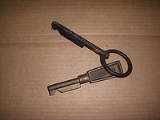
Reverser handle
Encyclopedia
A reverser handle is an operating control for a railroad locomotive
that is used to determine the direction of travel. The reverser usually has three positions: forward
, reverse
, and neutral.
When the reverser is in the forward or reverse position, the locomotive will move in the indicated direction when the throttle
is opened. Removing the reverser handle from the control stand in the neutral position locks the throttle controller, effectively disabling the locomotive. The reverser lever is sometimes referred to as a "railroad key."
A reversing mechanism of some type has been present on locomotives almost since inception. The style of reverser used on internal combustion locomotives
has been in use since at least the early 1900's but as late as 1996 patented improvements have been made to the design and operation.
Locomotive
A locomotive is a railway vehicle that provides the motive power for a train. The word originates from the Latin loco – "from a place", ablative of locus, "place" + Medieval Latin motivus, "causing motion", and is a shortened form of the term locomotive engine, first used in the early 19th...
that is used to determine the direction of travel. The reverser usually has three positions: forward
Relative direction
The most common relative directions are left, right, forward, backward, up, and down. No absolute direction corresponds to any of the relative directions. This is a consequence of the translational invariance of the laws of physics: nature, loosely speaking, behaves the same no matter what...
, reverse
Reverse
Reverse may refer to:*The reverse side of currency or a flag; see Obverse and reverse*A change in the direction of:**the movement of a motor or other prime mover; see Transmission **an engineering design: see Reverse engineering...
, and neutral.
When the reverser is in the forward or reverse position, the locomotive will move in the indicated direction when the throttle
Throttle
A throttle is the mechanism by which the flow of a fluid is managed by constriction or obstruction. An engine's power can be increased or decreased by the restriction of inlet gases , but usually decreased. The term throttle has come to refer, informally and incorrectly, to any mechanism by which...
is opened. Removing the reverser handle from the control stand in the neutral position locks the throttle controller, effectively disabling the locomotive. The reverser lever is sometimes referred to as a "railroad key."
A reversing mechanism of some type has been present on locomotives almost since inception. The style of reverser used on internal combustion locomotives
Diesel locomotive
A diesel locomotive is a type of railroad locomotive in which the prime mover is a diesel engine, a reciprocating engine operating on the Diesel cycle as invented by Dr. Rudolf Diesel...
has been in use since at least the early 1900's but as late as 1996 patented improvements have been made to the design and operation.

